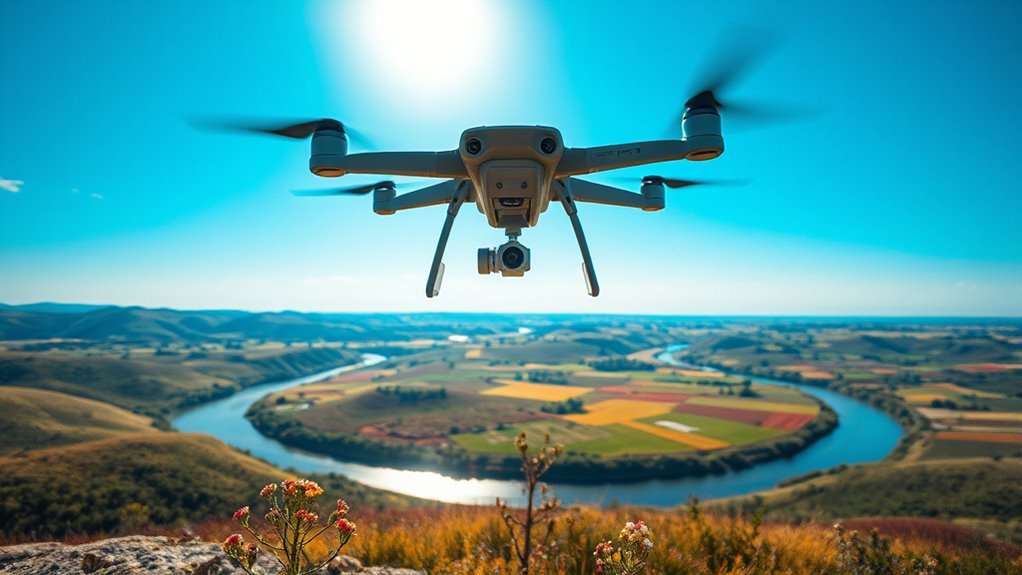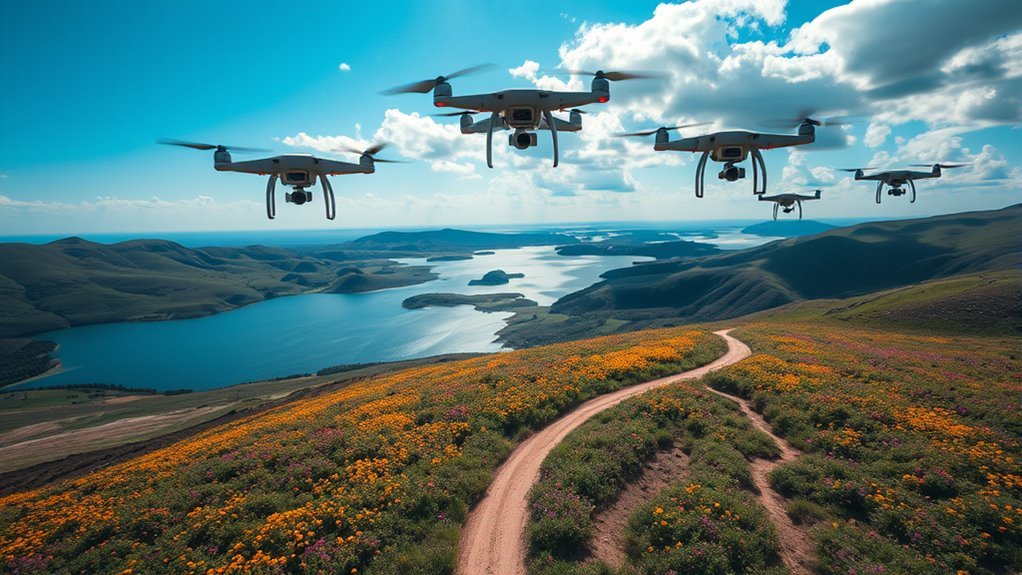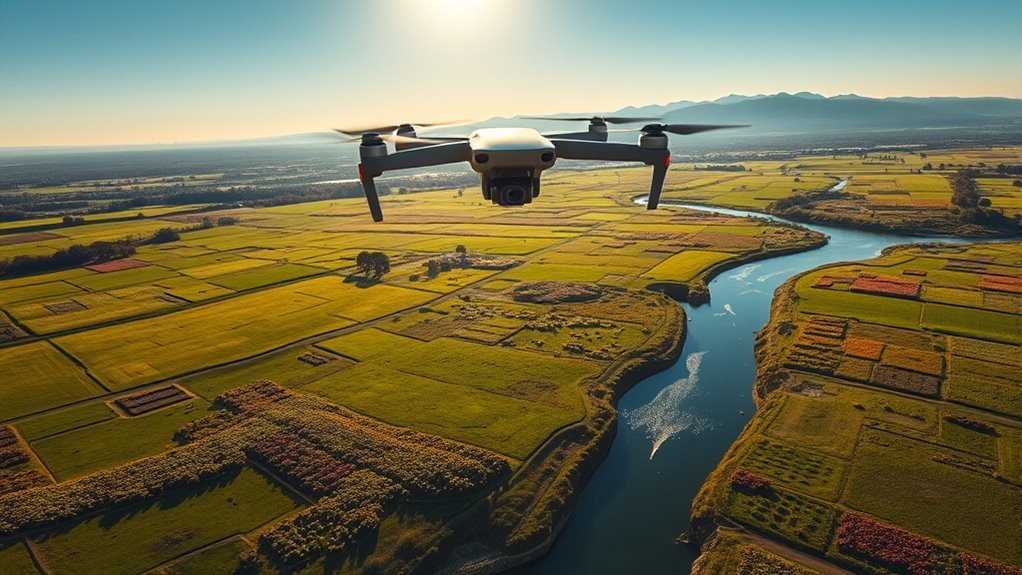Drones take pictures through a combination of advanced camera systems and stabilization technology. They leverage high-resolution sensors and sophisticated gimbal systems to guarantee sharp images, even during flights. GPS and smart navigation techniques allow for precise positioning and control. Real-time feedback helps you adjust camera angles for ideal shots, enhancing creativity. With various applications, drones transform your photography experience, offering unique perspectives. There’s more to explore in how technology shapes aerial imagery!
The Evolution of Drone Technology

As drone technology has advanced rapidly over the past decade, you might be surprised to learn just how far we’ve come from the early days of remote-controlled aircraft. Initially, drones were primarily military tools, but their evolution into versatile, consumer-friendly devices marks a significant chapter in drone history. Technological advancements like GPS navigation and real-time data transmission have transformed these aerial machines into essential tools for photographers and hobbyists alike. The integration of autonomous flight capabilities allows you to capture stunning aerial shots with precision and creativity. AI enhances flight safety through real-time obstacle detection, further improving the reliability of drone photography. Battery life has improved markedly, offering longer flight times, while compact designs make drones more accessible than ever. This evolution not only reflects innovation but also empowers you to explore new perspectives in photography. Moreover, advanced AI integration enhances drone performance and user experience, making aerial photography more intuitive and creative than ever.
Camera Specifications and Capabilities

When you’re choosing a drone for photography, understanding camera specifications is essential. Different camera types impact image quality considerably, and knowing how factors like sensor size and resolution play a role can elevate your shots. Plus, exploring various lens options allows you to tailor your drone to specific shooting scenarios, enhancing your creative possibilities. For instance, drones like the DJI Air 3 feature a dual-camera system that greatly improves versatility in capturing diverse types of images. Additionally, drones with a 1/2.3-inch CMOS sensor provide high-resolution imagery that can significantly enhance your photography.
Camera Types Overview
Drones equipped with advanced cameras have revolutionized aerial photography, offering a variety of specifications and capabilities that cater to different needs. Understanding the camera types and their drone compatibility is essential for maximizing your creative potential. Here’s a quick overview of popular camera types used in drones:
| Camera Type | Key Features |
|---|---|
| CMOS Sensor | High dynamic range |
| Micro Four Thirds | Interchangeable lenses |
| 1-Inch Sensor | Superior low-light performance |
| 360-Degree Cameras | Immersive panoramic views |
Each type offers distinct advantages, from capturing stunning landscapes to facilitating immersive experiences. By choosing the right camera type, you can enhance your aerial photography journey and truly release your artistic vision.
Image Quality Factors
While selecting a drone, it’s essential to contemplate the impact of camera specifications on image quality, as these factors can greatly influence your final results. Image resolution is a critical element; higher resolutions allow for greater detail and clarity, enabling you to crop images without losing quality. Equally important is sensor size; larger sensors typically capture more light, improving performance in low-light conditions and enhancing dynamic range. This allows you to produce vibrant, rich images that truly represent the scene. Don’t overlook the balance between these specifications—finding the right combination can liberate your creativity, ensuring your aerial photography stands out. Investing time in understanding these elements will ultimately empower you to capture breathtaking visuals from the sky.
Lens Options Explained
Choosing the right lens for your drone can greatly impact your aerial photography, as it dictates how you capture the world from above. Wide angle lenses are perfect for expansive landscapes, allowing you to embrace the grandeur of nature in a single shot. They create a sense of depth and space, making your images feel immersive. On the other hand, telephoto options give you the power to zoom in on distant subjects, revealing intricate details that are often missed from afar. This versatility allows you to tailor your perspective, whether you want to showcase a sweeping vista or focus on a lone subject in the distance. Ultimately, the lens you choose will unleash your creative potential and elevate your aerial storytelling.
Stabilization Techniques for Sharp Images

To capture sharp images, you’ll want to understand the crucial stabilization techniques your drone employs. Gimbal stabilization systems counteract vibrations, while GPS positioning accuracy guarantees your drone remains steady in the air. Additionally, image processing algorithms refine your shots, eliminating motion blur and enhancing clarity. The incorporation of advanced gyroscopic and electronic stabilization minimizes shakes and vibrations, ensuring your footage remains steady during dynamic shoots. Furthermore, the sophisticated image stabilization system featured in drones like the XG Neith enhances the overall quality of your visual content.
Gimbal Stabilization Systems
Gimbal stabilization systems are essential for achieving sharp, high-quality images in drone photography. These devices counteract the drone’s movements, allowing you to capture stunning visuals, even in windy conditions. There are various gimbal types, including two-axis and three-axis systems, each designed to stabilize your camera differently. The three-axis gimbal is particularly popular, providing superior stabilization benefits by adjusting pitch, yaw, and roll. This means you can shoot cinematic footage without the jarring shakes that often plague aerial photography. By harnessing the power of gimbal technology, you can release your creative freedom, exploring dynamic angles and perspectives that elevate your photography. Ultimately, a well-chosen gimbal system transforms your drone into a versatile tool for breathtaking imagery.
GPS Positioning Accuracy
Accurate GPS positioning is essential for capturing sharp images in drone photography, especially when flying at varying altitudes and distances. When you harness satellite connectivity, your drone gains the ability to perform altitude adjustments with precision, reducing the risk of blurry shots. To guarantee ideal GPS positioning, consider these techniques:
- Pre-flight Checks: Verify your drone’s GPS signal strength and satellite lock.
- Altitude Calibration: Adjust your drone’s altitude settings according to the photography requirements.
- Stable Flight Path: Maintain a steady course to minimize vibrations and movement.
- Real-time Monitoring: Use apps to track your drone’s position and adjust as needed.
Image Processing Algorithms
Even with precise GPS positioning, the clarity of drone-captured images can still be compromised by factors like wind or drone vibrations. That’s where image processing algorithms come into play. These algorithms utilize stabilization techniques that analyze data to enhance image sharpness. By correcting motion blur and optimizing focus, your photos can achieve that crisp quality you crave.
| Technique | Description | Benefits |
|---|---|---|
| Gyroscopic Stabilization | Uses sensors to detect movement | Reduces blurriness |
| Digital Stabilization | Adjusts pixels post-capture | Enhances fine details |
| Image Fusion | Combines multiple shots | Increases dynamic range |
Flight Navigation and Control Systems
While it might seem straightforward, the intricacies of flight navigation and control systems in drones are what truly elevate aerial photography. These systems enable precise movement and stability, allowing you to capture stunning images from the sky. Understanding these components can enhance your creative freedom:
The complexities of drone navigation systems elevate aerial photography, enabling stunning images and creative exploration from the skies.
- GPS and Sensors: They provide location data, ensuring autonomous navigation. This capability is essential for achieving mapping precision during aerial photography missions.
- Inertial Measurement Units (IMUs): These track orientation and maintain stability in varying flight dynamics.
- Flight Controllers: They interpret data and adjust motor speeds for controlled maneuvers.
- Waypoints and Path Planning: You can set specific routes for capturing unique angles and perspectives.
With these advanced systems in play, your drone transforms into a powerful tool, letting you explore the skies and release your artistic vision. Additionally, the integration of advanced AI can optimize flight patterns for even more dynamic photography opportunities.
The Importance of Real-Time Feedback
As you maneuver your drone through the sky, real-time feedback becomes an essential ally in achieving the perfect shot. With real-time monitoring, you can assess camera angles, lighting conditions, and subject movement instantly. This immediate data allows you to make quick adjustments, ensuring your images capture the essence of the moment. Imagine framing a breathtaking landscape only to realize it’s slightly off; instant feedback lets you tweak your position effortlessly. Additionally, it enhances your control, allowing for creative freedom as you explore various perspectives. By embracing this technology, you turn every flight into a dynamic shooting experience, transforming your vision into stunning visuals with unparalleled precision. Real-time feedback empowers you, making every click count in your aerial photography journey. Furthermore, the integration of advanced sensors and AI algorithms contributes to mapping precision, allowing for even greater accuracy in your aerial shots. This technology also benefits from AI integration, enabling smarter, adaptive performance that enhances your imaging capabilities.
Creative Uses of Drone Photography
When you harness the power of drone photography, you’re opening up a world of creative possibilities that traditional photography simply can’t match. With aerial perspectives, you can transform your shots in ways that inspire freedom and imagination. Here are four creative uses to examine:
- Landscape Artistry: Capture sweeping vistas that highlight natural patterns and textures.
- Event Documentation: Showcase gatherings from above, revealing the scale and ambiance.
- Urban Exploration: Uncover unique angles of city architecture, emphasizing lines and symmetry.
- Sports Action: Record dynamic movements from unexpected heights, providing thrilling viewpoints.
These creative compositions not only elevate your portfolio but also engage viewers like never before, encouraging them to see the world from a fresh perspective. Drones equipped with high-resolution sensors enhance the quality of aerial imagery, making your photographs even more captivating.
Frequently Asked Questions
What Types of Drones Are Best for Photography?
When choosing drone types for photography, consider those with high-resolution cameras, gimbal stabilization, and smart shooting modes. Drones like the DJI Mavic Pro or Phantom 4 offer impressive photography features, ensuring stunning aerial captures.
How Much Do Drone Photography Services Typically Cost?
When considering drone pricing, you’ll find service packages typically range from $100 to $500 per hour, depending on the complexity and scope. Higher-end options may offer additional features, enhancing your aerial photography experience greatly.
Are There Legal Restrictions on Drone Photography?
Yes, there’re legal restrictions on drone photography. You’ll need to understand drone regulations and airspace restrictions to guarantee compliance. Ignoring these can lead to fines or restrictions, limiting your creative freedom in capturing stunning aerial images.
How Can I Improve My Drone Photography Skills?
To improve your drone photography skills, focus on mastering composition techniques like rule of thirds and leading lines. Experiment with editing software to enhance your images, creating a unique style that reflects your creative vision.
What Accessories Enhance Drone Photography?
Did you know that using filters can improve your drone images by up to 60%? For stunning shots, consider gimbal stabilization for smooth capturing and enhance colors with filters, giving you the freedom to explore creativity effortlessly.

